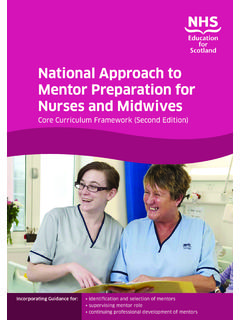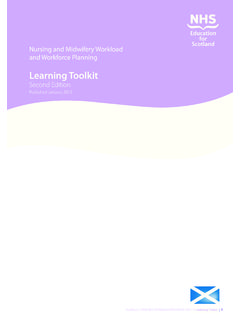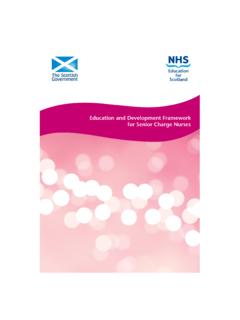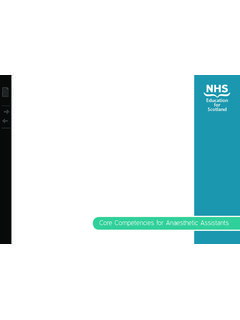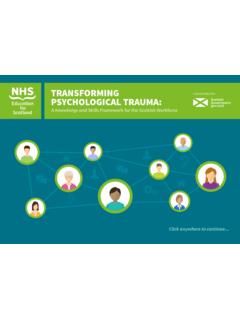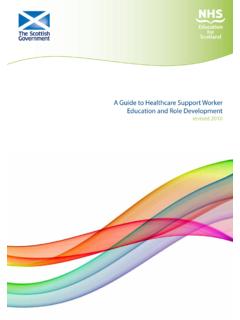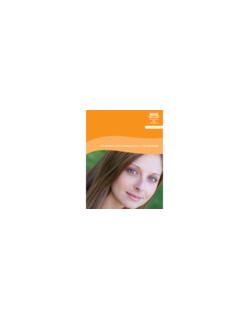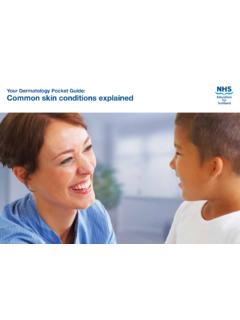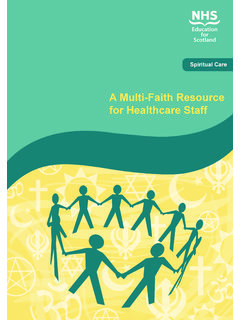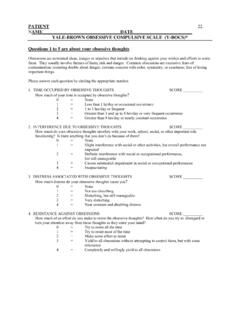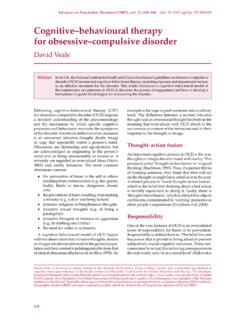Transcription of The Matrix Evidence Tables ADULT MENTAL HEALTH
1 The Matrix Evidence TablesADULT MENTAL HEALTHCLICK ANYWHERE TO CONTINUEINDEX Evidence Tables ADULT MENTAL HEALTH THE Matrix | A GUIDE TO DELIVERING Evidence -BASED PSYCHOLOGICAL THERAPIES IN SCOTLAND 2 PANIC DISORDER WITH/WITHOUT AGORAPHOBIAL evel of SeverityLevel of ServiceIntensity of InterventionWhat Intervention?RecommendationSubclinical (Prevention of PD among those presenting with panic attacks but not meeting PD diagnostic criteria)Primary CareLowStepped-care programme comprising educational booklet; detailed self-help manual; five x 2-hour group CBTA 1 LowOnline self-help CBT Programme for Prevention of Panic DisorderB 7 LowBrief Exposure Instruction (therapist-delivered)B 19 MildPrimary CareLowMinimal Therapy Contact CBT (4-6 hours) with.
2 BibliotherapyA 5, 13 Internet-deliveryA 3, 4, 9, 10, 18 ModeratePrimary CareLowTherapist-supported CBT (6-12 hours) augmented by CBT self-helpa) BibliotherapyA 5, 11, 16b) Computer-Assisted ( FearFighter)A 8, 14c) Internet-delivered CBT with therapist contact (up to six hours)A 4, 9, 10, 18d) Group CBT (8-18 hours)A 11, 17, 20 UPDATED 2014 Evidence Tables ADULT MENTAL HEALTH THE Matrix | A GUIDE TO DELIVERING Evidence -BASED PSYCHOLOGICAL THERAPIES IN SCOTLAND 3 Level of SeverityLevel of ServiceIntensity of InterventionWhat Intervention?RecommendationSeverePrimary Care/Secondary CareHighIndividual Therapist-Directed CBT (16-20 sessions) with supplementary written materialCBT with medication more effective than medication alone. Some Evidence of trend for CBT plus antidepressants to have slightly greater effect in acute phase compared with CBT alone, but difference not maintained at 6-24 months follow-upA 2, 6, 12, 13, 15 Chronic or Treatment ResistantSecondary Care/Specialist Service.
3 In-Patient CareHighIndividual Therapist-Directed CBT (up to 20 sessions)CModerate to Severe, following positive response to CBTP rimary Care/Secondary CareHighMaintenance-CBT following CBT Reduced chance of relapse Reduced work and social impairmentA 21 PANIC DISORDER WITH/WITHOUT AGORAPHOBIA Evidence Tables ADULT MENTAL HEALTH THE Matrix | A GUIDE TO DELIVERING Evidence -BASED PSYCHOLOGICAL THERAPIES IN SCOTLAND 4 SOCIAL ANXIETY / SOCIAL PHOBIAL evel of SeverityLevel of ServiceIntensity of InterventionWhat Intervention?RecommendationMildPrimary Care, Voluntary settingsLowGuided self-help (bibliotherapy or internet-based)A 1, 2 Moderate to SeverePrimary Care, Voluntary settingsHighIndividual or group CBT (Clark/Wells or Heimberg models, including Exposure, and Cognitive restructuring or social skills training)A 3, 4, 5, 6, 7, 10, 11, 12 HighInterpersonal TherapyB 8, 11 HighShort-term Psychodynamic (focused on social anxiety)B 9, 10 HighHumanistic-Person-Centred-Experienti al (focused on social anxiety)C 13 Avoidant PDPrimary Care/Secondary CareHighCBT (20 sessions)
4 A 9 UPDATED 2014 Evidence Tables ADULT MENTAL HEALTH THE Matrix | A GUIDE TO DELIVERING Evidence -BASED PSYCHOLOGICAL THERAPIES IN SCOTLAND 5 GENERALISED ANXIETY DISORDERL evel of SeverityLevel of ServiceIntensity of InterventionWhat Intervention?RecommendationMildPrimary careLowMulti-modal CBTA 2 LowGuided self-helpB 3, 6 LowLarge group psychoeducationB 8 LowBrief counsellingCModerate to SeverePrimary Care/Secondary CareHighCBT (8-16 sessions over 10 weeks 6 months)A 1, 5, 9 Severe and ChronicSecondary CareHighCBT (20 sessions over 6 months) delivered to a specialist treatment protocol for GADB 4, 5 UPDATED 2014 Evidence Tables ADULT MENTAL HEALTH THE Matrix | A GUIDE TO DELIVERING Evidence -BASED PSYCHOLOGICAL THERAPIES IN SCOTLAND 6 obsessive COMPULSIVE DISORDERL evel of SeverityLevel of ServiceIntensity of InterventionWhat Intervention?
5 RecommendationMildPrimary CareLowCBT including Exposure and Response Prevention (ERP) (c) with less than 10 therapist hours which should consist of: Individual contact supported by self-help materials Brief individual telephone contact. Group sessions but with more than 10 hours of therapy (b)B 1, 2, 3, 7, 8 ModerateSecondary CareHighCBT/ERP*. More than 10 hours of therapist guided ERP including sessions in the most salient environment, public toilets, homeA 1, 3, 4, 5, 7, 8 SevereSecondary CareHighCBT/ERP. More than 20 hours of therapist guided ERP including sessions in the most salient environment, public toilets, home. augmented with anti-obsessional medicationA 1, 3, 4, 5 ExtremeSpecialist ServicesHighCBT/ERP. More than 20 hours of therapist guided ERP including sessions in the most salient environment, public toilets, home.
6 Augmented with anti-obsessional medication plus anti-psychotic B 1, 6 NOTES:a) The use of the yale brown obsessive Compulsive Scale (Y-BOCS) is recommended to establish severity7, 9Y-BOCS Ranges:Mild 8-15 Moderate 16-23 Severe 24-31 Extreme 32-40b) Some individuals (15-20%) may have obsessions around the themes of blasphemy, sexual taboos, or violence that preclude group work at even mild levels of severityc) Like other exposure therapies this should combine in vivo and imaginal exposure. The most common problem is not ensuring the person understands and complies with response preventionUPDATED 2014 Evidence Tables ADULT MENTAL HEALTH THE Matrix | A GUIDE TO DELIVERING Evidence -BASED PSYCHOLOGICAL THERAPIES IN SCOTLAND 7 PSYCHOSIS (INCLUDING THOSE DIAGNOSED WITH SCHIZOPHRENIA) PREVENTING PSYCHOSISL evel of SeverityLevel of ServiceIntensity of InterventionWhat Intervention?
7 RecommendationModerate / SeverePrimary / Secondary CareHigh Intensity / specialist interventionsCognitive Behaviour Therapy 1A 1 - 4 High Intensity / specialist interventionsFamily Intervention 2A 1 1 CBT should be delivered on a one-to-one basis over at least 16 planned sessions and follow a treatment manual so that:(a) people can establish links between their thoughts, feelings or actions and their current or past symptoms, and/or functioning (b) the re-evaluation of people s perceptions, beliefs or reasoning relates to the target symptoms and (c) also include at least one of the following components: people monitoring their own thoughts, feelings or behaviours with respect to their symptoms or recurrence of symptoms, promoting alternative ways of coping with the target symptom, reducing distress or improving Family intervention should include (a) the person with psychosis or schizophrenia if practical (b) be carried out for between 3 months and 1 year (c) include at least 10 planned sessions (d) take account of the whole family s preference for either single-family intervention or multi-family group intervention (e) take account of the relationship between the main carer and the person with psychosis or schizophrenia and (f)
8 Have a specific supportive, educational or treatment function and include negotiated problem solving or crisis management workUPDATED 2014 Evidence Tables ADULT MENTAL HEALTH THE Matrix | A GUIDE TO DELIVERING Evidence -BASED PSYCHOLOGICAL THERAPIES IN SCOTLAND 8 FIRST EPISODE PSYCHOSIS, SUBSEQUENT EPISODES AND PROMOTING RECOVERYL evel of SeverityLevel of ServiceIntensity of InterventionWhat Intervention?RecommendationSevereSeconda ry CareHigh Intensity / specialist interventionsCognitive Behaviour Therapy A 1, 5 - 10 High Intensity / specialist interventionsFamily InterventionA 1, 5, 11, 12 RehabilitationHigh Intensity / specialist interventionsCognitive Remediation TherapyA 5, 13 Secondary CareHigh Intensity / specialist interventionsMetacognitive TherapyB 14 High Intensity / specialist interventionsMindfulnessB 15 - 27 Low intensityEarly Signs MonitoringA 28 - 30 PSYCHOSIS (INCLUDING THOSE DIAGNOSED WITH SCHIZOPHRENIA)
9 Evidence Tables ADULT MENTAL HEALTH THE Matrix | A GUIDE TO DELIVERING Evidence -BASED PSYCHOLOGICAL THERAPIES IN SCOTLAND 9 BIPOLAR DISORDERPRIMARY OUTCOME PREVENTION OF RELAPSEL evel of SeverityLevel of ServiceIntensity of InterventionWhat Intervention?RecommendationSevere and EnduringSecondary CareHighCaregiver group psychoeducation and family psychoeducation for Prevention of Relapse in depression and/or maniaA 6, 7 HighGroup psychoeducation for Prevention of Relapse in depression and/or maniaA 2, 3, 8 OTHER OUTCOMESL evel of SeverityLevel of ServiceIntensity of InterventionWhat Intervention?RecommendationSevere and EnduringSecondary CareHighFunctional remediation for improvement in functional outcomesA 11 HighGroup psychoeducation and family psychoeducation for improved medication adherenceA 10, 6 HighInterpersonal and Social Rhythm Therapy (IPSRT) for regularity of social rhythmA 4 HighCognitive behavioural therapy for improved social functioningB 1, 5, 8, 9 There is no Evidence that care management, integrated group therapy or mindfulness-based cognitive therapy is effective in the prevention of relapse (Beynon et al.)
10 2008; Reinares et al. 2014). In relation to CBT, there is no strong Evidence to suggest that CBT is effective in the prevention of relapse. Scott et al. (2006), however, found that CBT may be effective in the prevention of relapse for patients with less than 12 2014 Evidence Tables ADULT MENTAL HEALTH THE Matrix | A GUIDE TO DELIVERING Evidence -BASED PSYCHOLOGICAL THERAPIES IN SCOTLAND 10 GOOD PRACTICE FOR PSYCHOLOGICAL THERAPIES FOR NON-PSYCHOTIC AFFECTIVE DISORDERS IN THE PERINATAL PERIOD SHOULD INCLUDE: Given the importance of early intervention in the maternity context, services delivering UPDATED 2014 NON PSYCHOTIC AFFECTIVE DISORDERS IN THE PERINATAL PERIOD psychological therapies should prioritise early response to pregnant and postnatal women An understanding of the perinatal context and its influence on non-psychotic affective disorders.
